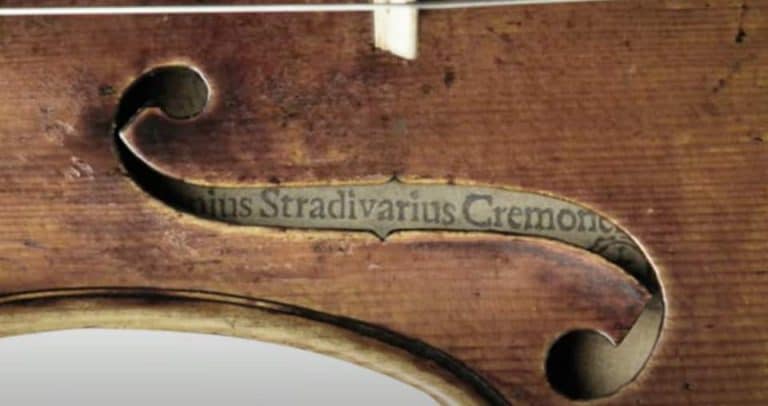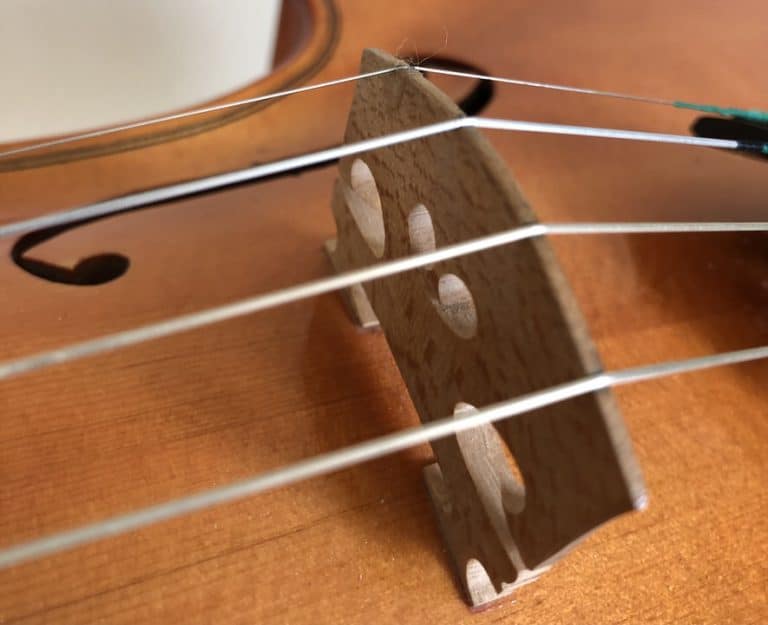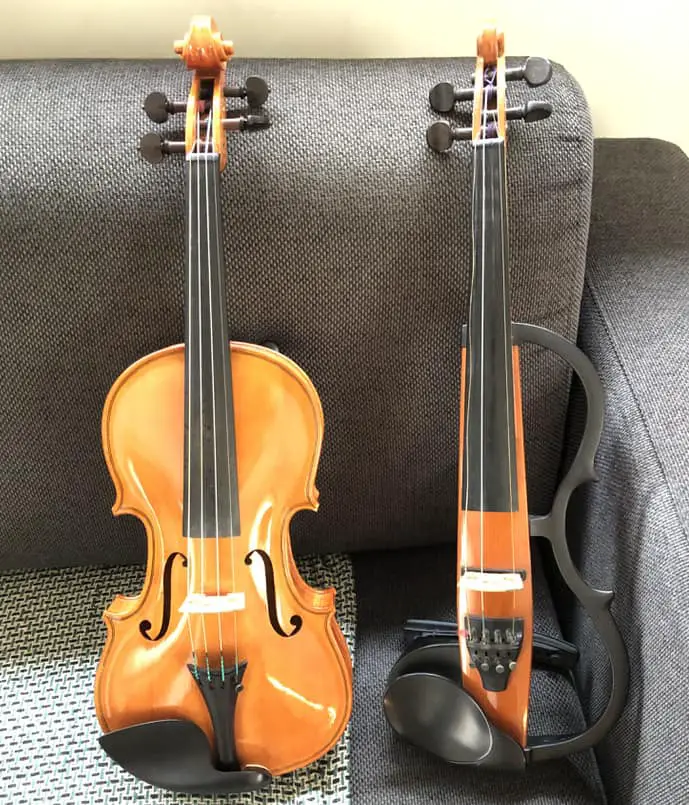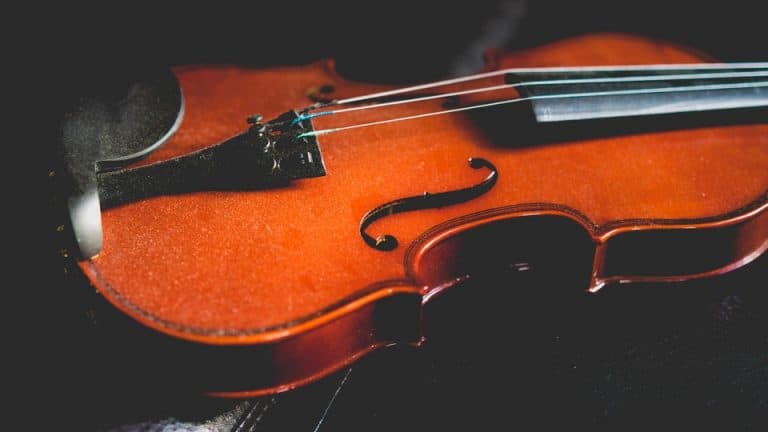9 Tips and your Violin E String Won’t Whistle Again
It has happened to a lot of players. We try to play as perfectly as possible and have a good tone and intonation. Then, suddenly, our E string gives that bright, loud, harsh sound: it has decided to whistle. We try to stay concentrated, but we fear that next time it might happen again, and this thought deteriorates our play’s quality. And this can occur to students, professional players, amateurs, Bluegrass fiddlers. So why? And what to do to solve this problem? These are my top 9 tips. Play freely again.
Why do violin E strings whistle?
A whistling E string is really annoying. It consists of basically a string that decides to give a harmonic instead of its given pitch. (A upper harmonic tone, of course, in that case, one or two octaves up.)
Such a high pitch sound is quite surprising, disturbing for the performer as well as the audience. Some violins are more prone than others to whistle, but even good violins happen to whistle. That phenomenon might be due to the string itself if it matches the violin, the rosin, the technique, and several other reasons that we are going to list. There are so many factors. Let’s examine the most important one to overcome that problem as quickly as possible.
TOP 9 tips to help your E string not to whistle
1. The string has to be perfectly clean and without corrosion.
Again, the E string has to be perfectly clean. As it is such a thin string, rosin glued on it can easily hinder the sound. Do not forget to clean under the string. If you wipe the rosin off with a cloth from the top, some rosin dust will still accumulate below the string and prevent it from vibrating. I speak from personal experience. Put the string in the cloth and clean every part of it with alcohol.
2. Pay attention when changing strings.
Some beginner students, when they change from the A string to the E string, tend to whistle because their bow is too far from the bridge. The A string can cope with that distance better than the E; the sweet spot of contact between the bow and the string is usually closer to the bridge for the E. It is something we have to keep in mind.
3. Pay attention to your left-hand fingers.
Beware not to have a finger from the left hand slightly touching the string, though not stopping it. That light touch will be enough to prevent the string from vibrating freely and will make it generate a harmonic instead. Unwanted harmonics are a common problem when playing chords or double-stops in Bach (second chord in the Chaconne – D G B flat E -where the first finger is playing the B flat on the A string tends to brush the open E, which makes a whistling sound. It happens to me a lot.)
4. Consider a string sleeve.
The last detail to consider is the string sleeve. The E string is so thin it tends to cut through the wood of the bridge, which is not a good thing. To avoid that, the string is often put inside a small plastic tube, a kind of sleeve, to protect to bridge. When tuning the violin, again and again, this sleeve tends to slide towards the scroll (that is to say, towards the vibrating part of the string). Take that sleeve back to the tailpiece of the violin, and the string will vibrate freely.
5. Perfect your technique!
For the E string to give a good, clean sound, the string has to vibrate freely. Let’s consider the string is clean, and the bow has the proper quantity of rosin to grip the string. If the fingers of the left hand are not in the way, then the bow arm plays an important part. The right arm has to give the proper weight (pressure) and feel relaxed. The motion has to be direct and without hesitation. The ribbon of the bow has to be rather flat to offer a better surface of contact. Too much contact is a risk for whistling because it prevents the string from vibrating, so a greater speed of the bow is sometimes recommended.
6. Experimenting with strings: change them.
E strings are so thin they tend to wear out even quicker than the rest of the set. Consequently, the first thing is to make sure that the string is in good condition or new. Do not hesitate to change the E string more often than the set. Some brands make special E strings that are not meant to be sold in a set but are stronger and specifically designed or engineered not to whistle. Try and experiment with those. High-tension strings have a bright, clear, and loud sound. For example, gold-plated strings tend to whistle even more. So consider buying a string that is designed not to whistle: Kaplan, D’Addario, Warchal have made strings that supposedly do not whistle. They have less tension, maybe less brilliance, but it worked for many players. They are usually aluminum wounded.
As there is nothing more frustrating than a whistling string in the middle of a passage and knowing it might whistle or not.
A slightly less bright sound is a good tradeoff, I suppose, unless you are Hilary Hahn, of course, in which case beauty sound is on top of every other technical consideration! See below for a complete chart of non-whistling E strings.
So It might be a good idea to complement that previous advice to start buying special E strings separately and not in a set. Just make your own set of strings by choosing the perfect strings for your needs. Big string makers engineer and produce special strings to avoid whistling. Some say that wound E strings tend to whistle less. But a wound string is usually bigger and less comfortable to play sometimes.
The Kaplan one is well-known and sounds great. I have used it myself a lot with success. It is my mentor E string of choice as well. The Pirastro Wondertone Solo E is quite good too, but I prefer the Kaplan or the Thomastik Infeld platinum-plated. The Thomastik is maybe a bit more expensive but has a great bright sound, maybe for soloists. I have many times stuck to Evah Pirazzi’s gold E and liked it. But to prevent whistling, the Larsen is quite good too.
Also, if you want to prevent corrosion long enough, a tin-plated E string might be a solution. They incorporate one or several protective metal layers. They are called multi-layered strings. Chromium steel strings, or stainless steel strings, are truly resistant to corrosion and are used without any plating for this reason. They tend to last longer and are in better condition, which definitely mitigates whistling.
Experiment with string tension as well. Try using the same string you have habitually but choose a less tension flavor. If you get more whistling, use a stronger tension instead. Considering the price of E strings, this might be a quick fix if any; do not hesitate.
Lastly, wound E-strings associate a wound of thin flat strips to a core of carbon steel. Their sound is darker and they provide a better bow response. They offer a different torsion rigidity and therefore whistle less as well.
7. Stop by your favorite violin maker.
If all the above have more or less failed, consider having your violin checked and tuned by a violin maker. Some instruments are more likely to whistle than others, and sometimes adjusting the bridge or the sound post might be a solution to that annoying problem. Ask for professional guidance. A violin is a complex instrument, and many parameters play essential parts. An instrument can cope with a certain string tension due to its own design – under the upper part of the violin, the harmony bar; that tension leaves room for the instrument to breathe and the string to vibrate. A violin maker will be perfectly able to choose the best string to go to your instrument
8. Experiment with rosin
Rosin is not just a product; the difference in play between several brands of rosins is impressive. To prevent whistling, you need a stickier or firmer one. Bow response will be improved. Choose rosin which gives more contact with the string. You can even mix alto rosin with violin one, for example using two-thirds of violin rosin and one-third of alto one. Just put violin rosin three times with three strokes on your bow for one time you use rosin for alto, this is pretty simple as you can’t really physically mix them. Try and use darker rosin. They are usually firmer and stick more than light or amber rosin. These are the rosins I have tested, used, and detailed on my recommended products page.
9. Change the hair of your bow.
Bow hair eventually wears out even if you don’t see any broken horsehair yet. The small structure of the hair is worn out and doesn’t vibrate the string properly even with enough or good rosin. Humidity can be a factor as well, which deteriorates the bow: water lifts the micro scales on the cuticle of the hair. If the climate changes often enough, bow hair has to be changed more often. So this is something to keep in mind but often overlooked.
These are the strings I prefer :
| Brand | Type | Strings that don’t whistle |
|---|---|---|
| D’Addario | Kaplan | Medium tension, Wound stranded steel core, Unique non-whistling E string |
| Warchal | Amber | Made of special steel alloy |
| Thomastik Infeld | Peter Infeld | platinum-plated E-string PI01PT |
In conclusion, I propose to you a must-read: my comprehensive guide on how to have a great sound on the violin. Here, I have detailed how the sound is produced and all the tips and tricks to produce a magical tone that will all dream about.
Alternatively, check out how to maintain your violin: this is important to know if you want to have strings in perfect condition.






